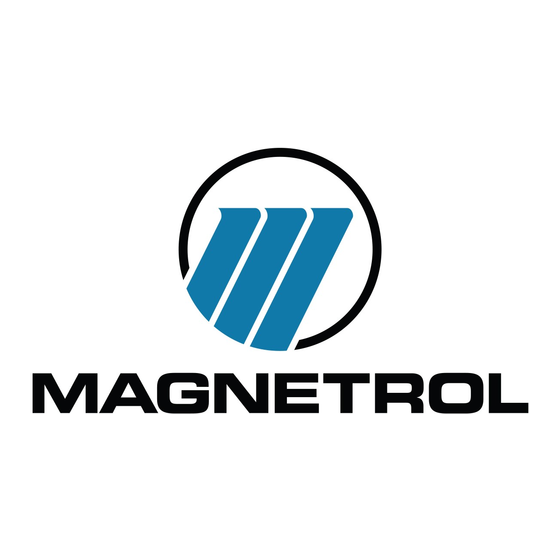
Summary of Contents for Magnetrol STI Kotron 810
- Page 1 Kotron ® Model 810 RF Point Level Sensor Installation and Operating Manual Capacitance Level Measurement...
- Page 2 Notice of Trademark, Copyright and Limitations Conventions Used in this Manual Magnetrol & Magnetrol logotype, STI and STI logotype, Certain conventions are used in this manual to convey and Kotron are registered trademarks of Magnetrol specific types of information. General technical material, International, Incorporated.
-
Page 3: Table Of Contents
Kotron Model 810 RF Point Level Sensor Table of Contents 1.0 Introduction 3.0 Reference Information ..........8 1.1 Principle of Operation...........1 3.1 Troubleshooting.............8 1.2 Electrostatic Discharge (ESD) Handling Procedure...1 3.1.1 No Signal with Level Change .....8 2.0 Installation 3.1.2 Switch Chatter..........8 2.1 Unpacking ............1 3.2 Agency Approvals ..........9 2.2 Electrostatic Discharge Handling Procedure ..2... -
Page 4: Introduction
Introduction The Kotron Model 810 RF Point Level Sensor can be utilized in liquid or bulk material applications. There are no moving parts in contact with the medium. These units are integral systems with the sensing probe mounted with the electronics. Guarded probes are utilized to minimize effect of build up on the probe. -
Page 5: Electrostatic Discharge Handling Procedure
Electrostatic Discharge (ESD) Handling Procedure Magnetrol’s electronic instruments are manufactured to the highest quality standards. These instruments use electronic components that may be damaged by static electricity pre- sent in most work environments. The following steps are recommended to reduce the risk of component failure due to electrostatic discharge. -
Page 6: Probe Length
2.3.2 Probe Length If the geometry of your application requires a probe short- er than 12" (305 mm) of active length, refer to Figure 1 below to determine the minimum dielectric constant in which it can be used. Probe Length vs. Dielectric Constant Figure 1 Minimum dielectric constant of material Mounting... -
Page 7: Wiring
Wiring All power and control connections are made at the terminal strip within the amplifier enclosure, EXCEPT GROUNDING. Power grounding must be made at green ground screw on the housing base. 16AWG wire is recommended for power and control circuits. Mounting Screws NOTE: There are special wiring requirements for intrinsic safety. - Page 8 OPERATING MODE SELECTION The chart below is provided to aid in the proper choice of relay wiring and calibration. Please note: 1. Equipment controlled by the relay is assumed to be pow- ered from one source, while the Model 810 itself is assumed to be powered from a different source.
-
Page 9: Calibration
Calibration Caution: In hazardous areas, do not remove housing cover until power is disconnected and atmosphere os determined to be safe. Hazardous environments must be declared safe by the local safety authority. 2.6.1 Calibration Procedure 1. Turn on power to the instrument. 2. - Page 10 2. Fail-safe High— a. Set DIP switch position 3 OFF and position 4 ON. b. Turn the LEVEL control counterclockwise until the LED turns off. c. Turn the LEVEL control clockwise until the LED turns on. d. If media is on probe, slowly turn the LEVEL control counterclockwise until the LED turns off.
-
Page 11: Reference Information
Reference Information Troubleshooting 3.1.1 No Signal with Level Change 1. Check power and control circuit wiring. 2. Check fail-safe switch position. 3. Check calibration. 4. Check for proper ground reference particularly in non- metal tanks. If removal of electronic module is necessary: 1. -
Page 12: Agency Approvals
Agency Approvals AGENCY APPROVED MODEL PROTECTION METHOD AREA CLASSIFICATION All models Explosion Proof Explosion proof with intrinsically safe probe circuit Class I, Div. 1, Groups C & D Class II, Div. 1, Groups E, F, & G General purpose NEMA 4X All models Explosion Proof Explosion proof with intrinsically safe probe circuit... -
Page 13: Specifications
Specifications 3.3.1 Electrical Supply voltage 120 VAC, 50–60 Hz (+10%, -15%) 240 VAC, 50–60 Hz (+10%, -15%) 24 VDC (±10%) 12 VDC (±10%) Power consumption 120 or 240 VAC Less than 5 volt-amps 12 or 24 VDC 1 watt maximum Zero range 0 pF minimum to 500 pF maximum Fixed differential... -
Page 14: Replacement Parts
Replacement Parts Description Part Number 120 VAC Z30-9101-001 Œ Complete Electronic Assembly Œ 240 VAC Z30-9101-002 24 VDC Z30-9101-004 12 VDC Z30-9101-003 Aluminum 04-9105-001 Cover 316 SS 04-9142-00 Ž O-ring 12-2101-345 Aluminum ⁄ " NPT conduit connection 04-9182-002 Base 316 SS, single hub 04-9140-001... -
Page 15: Model Numbers
Model Numbers BASIC MODEL Kotron RF Capacitance Level Switch INPUT POWER 120 VAC 240 VAC 24 VDC 12 VDC HOUSING NEMA 4X/7/9 Groups C & D, aluminum, ⁄ " NPT conduit NEMA 4X/7/9 Groups C & D, 316 SS, ⁄ "... - Page 16 No claims for misapplication, labor, direct or consequen- tial damage will be allowed. 5300 Belmont Road • Downers Grove, Illinois 60515-4499 • 630-969-4000 • Fax 630-969-9489 • www.magnetrol.com 145 Jardin Drive, Units 1 & 2 • Concord, Ontario Canada L4K 1X7 • 905-738-9600 • Fax 905-738-1306 Heikensstraat 6 •...


Need help?
Do you have a question about the STI Kotron 810 and is the answer not in the manual?
Questions and answers